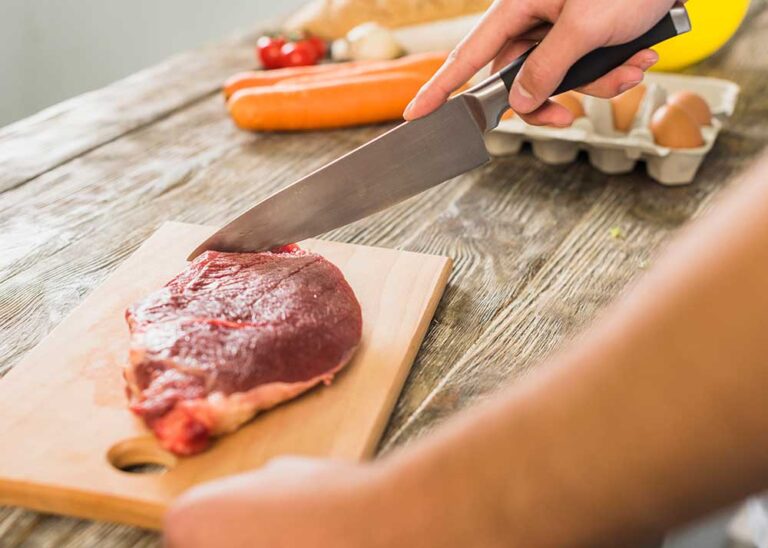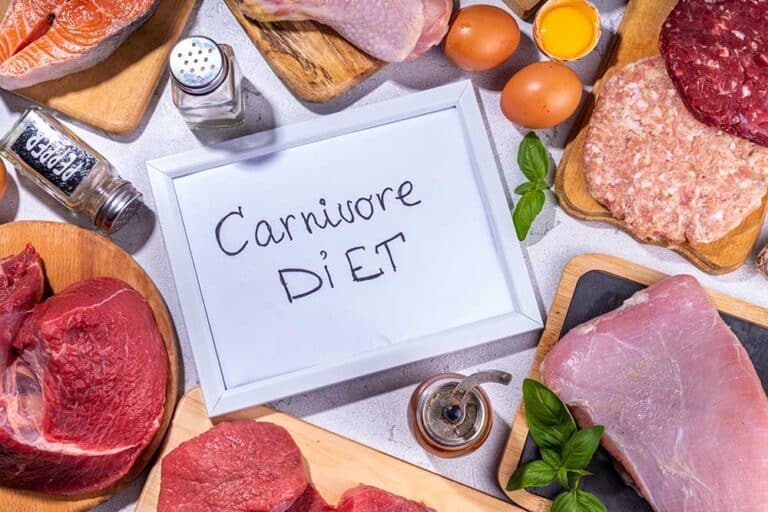Understanding the Carnivore Diet
Basics of the Carnivore Diet
The carnivore diet focuses exclusively on animal products. It consists entirely of meat, fish, eggs, and certain dairy products, while excluding all other foods like fruits, vegetables, legumes, grains, nuts, and seeds (Healthline). This approach is considered a “zero carb” diet as it eliminates carbohydrates, relying solely on proteins and fats for energy.
Essentially, followers of this diet consume:
- Meat (beef, pork, lamb)
- Poultry (chicken, turkey)
- Fish and seafood (salmon, tuna, shrimp)
- Eggs
- Some dairy products (butter, hard cheeses)
To minimize lactose intake, the diet recommends limiting dairy to low-lactose options. It’s crucial for individuals to focus on nutrient-dense animal products to avoid potential nutrient deficiencies.
| Category | Allowed Foods |
|---|---|
| Meat | Beef, Pork, Lamb |
| Poultry | Chicken, Turkey |
| Fish and Seafood | Salmon, Tuna, Shrimp |
| Eggs | Chicken Eggs, Duck Eggs |
| Dairy | Butter, Hard Cheeses |
Benefits and Criticisms
The carnivore diet garners both praise and criticism. Supporters argue that it can lead to several health benefits, including:
- Weight Loss: By inducing the body to burn fat, the diet can help with weight loss (Harvard Health Publishing). However, experts generally advise against using the carnivore diet solely for this purpose.
- Improved Mental Clarity: Some proponents claim enhanced cognitive function due to stable blood sugar levels.
- Reduced Inflammation: Eliminating plant-based foods may reduce inflammation for some individuals.
Despite these reported benefits, the diet also faces significant criticisms:
- Nutrient Deficiencies: Excluding all plant foods can lead to deficiencies in vitamins and micronutrients such as Vitamin C, fiber, and antioxidants (Carnivore Snax).
- Impact on Gut Health: The lack of fiber may affect gut flora negatively (Harvard Health Publishing).
- Long-Term Health: The long-term effects are not well-studied, raising concerns about sustainability and safety.
For more on this topic, see our articles on carnivore diet benefits and carnivore diet side effects.
These aspects of the carnivore diet are vital to understand before considering it as a lifestyle choice. It is always advisable to consult healthcare professionals when making significant changes to one’s diet.
Explore more on what can you eat on the carnivore diet and start planning your meals with our carnivore diet meal plan.
Foods Allowed on the Carnivore Diet
When following the carnivore diet, it’s essential to know which foods are allowed to ensure the diet’s nutritional balance and effectiveness. Below is a detailed breakdown of permissible foods that satisfy the cravings of those on this diet.
Meat Options
Meat forms the backbone of the carnivore diet, offering essential nutrients such as protein and fat, which provide energy and support muscle growth.
| Meat Type | Calories (per 4 oz.) | Fat (g) | Protein (g) |
|---|---|---|---|
| Beef | 265 | 19 | 21 |
| Chicken | 187 | 4 | 35 |
| Pork | Varies | Varies | Varies |
| Lamb | Varies | Varies | Varies |
According to Carnivore Snax, beef is a favorite due to its high-fat content and versatility in preparation. Chicken is another popular choice, especially for those looking for a lower-fat option.
Fish and Seafood Choices
Fish and seafood are valuable additions to the carnivore diet due to their high protein content and lower calorie and fat levels compared to other meats.
| Fish/Seafood Type | Calories (per 4 oz.) | Fat (g) | Protein (g) |
|---|---|---|---|
| Grilled Fish | 124 | 1.5 | 25.6 |
| Salmon | Varies | Varies | Varies |
| Trout | Varies | Varies | Varies |
| Oysters | Varies | Varies | Varies |
| Clams | Varies | Varies | Varies |
As per Carnivore Snax, including fish like salmon and trout, and seafood like oysters and clams, enriches the diet with essential fatty acids and micronutrients.
Dairy Products and Seasonings
Though the focus is on animal-based products, some dairy items and seasonings are allowed in small amounts to add variety and flavor.
| Product/Seasoning | Allowed? |
|---|---|
| Cheese | Yes |
| Butter | Yes |
| Heavy Cream | Yes |
| Eggs | Yes |
| Salt | Yes |
| Pepper | Yes |
| Chili Paste | Yes |
| Cumin | Yes |
| Paprika | Yes |
| Garlic | Yes |
As noted by WebMD, permissible foods include various dairy products such as cheese, butter, and heavy cream, along with eggs. Spices like salt, pepper, and a few others can be used for seasoning to enhance the taste of meat-based dishes.
For those looking to explore meal ideas and recipes compliant with the carnivore diet, check out our articles on carnivore diet meal plan and carnivore diet recipes.
By understanding the approved foods on the carnivore diet, individuals can create satisfying meals that align with the dietary guidelines while enjoying the health benefits associated with this eating pattern. For more information, including potential benefits, visit our article on carnivore diet benefits.
Potential Risks and Concerns
Adopting the carnivore lifestyle involves consuming animal-based foods exclusively. While it has gained popularity, this diet is not without its risks and concerns. Understanding these potential issues will help determine if this diet is suitable.
Nutrient Deficiencies
One significant concern with the carnivore diet is the risk of nutrient deficiencies. This diet excludes plant-based foods, which are essential sources of various vitamins and minerals.
| Nutrient | Source | Deficiency Risk |
|---|---|---|
| Fiber | Plants | High |
| Folate | Leafy greens | Moderate |
| Vitamin C | Fruits, Veggies | High |
| Antioxidants | Plants | High |
Due to the absence of fruits and vegetables, those following the carnivore diet may lack essential nutrients like fiber, folate, and vitamin C (Healthline). It is crucial to monitor these levels and consider supplementation if deficiencies are suspected.
For a detailed list of what you can eat on this diet, check out our carnivore diet foods list.
Impact on Gut Health
Fiber plays a vital role in maintaining optimal gut health. A carnivore diet eliminates dietary fiber entirely, leading to potential digestive issues such as constipation and poor gut health.
| Health Impact | Associated Risk |
|---|---|
| Constipation | High |
| Gut Inflammation | Moderate |
| Reduced Gut Microbiome Diversity | High |
Lack of fiber can negatively impact the gut microbiome, leading to decreased gut flora diversity and possible inflammation. Maintaining gut health is essential, so it’s important to weigh these risks before committing to the diet (Healthline).
Long-Term Health Considerations
Long-term adherence to the carnivore diet can pose several health concerns beyond nutrient and gut health issues. The high intake of saturated fats and cholesterol from animal products raises concerns about cardiovascular health.
| Health Concern | Risk Level |
|---|---|
| Elevated LDL (Bad) Cholesterol | High |
| Impaired Kidney Function | Moderate |
| Increased Risk of Gout | Moderate |
| Osteoporosis Risk | Moderate |
Animal fats in the diet predominantly contain saturated fats, which can elevate LDL (bad) cholesterol levels, increasing cardiovascular risks (Harvard Health Publishing). Additionally, high protein intake may lead to kidney function impairment and an increased risk of kidney stones and gout (Harvard Health Publishing).
For more insights into potential adverse effects, you can visit our page on carnivore diet side effects.
Considering these risks and concerns, it’s essential to conduct thorough research and consult a healthcare professional before starting the carnivore diet. If you’ve decided to proceed, our carnivore diet meal plan can guide you in building balanced meals. Understanding the potential risks and how to mitigate them can help you make an informed decision about adopting this diet.
Carnivore Diet Meal Plan
Navigating the carnivore diet requires planning to ensure each meal is balanced and nutritious. This section provides guidance on building meals and offers sample meal ideas to help you get started.
Building a Balanced Meal
The carnivore diet is unique in that it focuses exclusively on animal-based products. When constructing a meal, it’s important to incorporate a variety of protein sources to meet your nutritional needs. Here are some key points to consider:
- Protein Variety: Include different types of meat, poultry, fish, and seafood.
- Quality Fats: Ensure adequate fat intake by choosing cuts of meat with higher fat content or adding sources like butter or ghee.
- Organ Meats: Incorporate organ meats for a richer nutrient profile.
- Dairy in Moderation: Use cheese, milk, and yogurt sparingly due to potential inflammatory effects.
Sample Balanced Meal Plan
| Meal | Protein Source | Fat Source | Optional Additions |
|---|---|---|---|
| Breakfast | Eggs | Bacon | Hard cheese (limited) |
| Lunch | Grilled Steak | Added butter | Salt, Pepper |
| Dinner | Baked Salmon | Olive oil | Dill, Lemon juice |
| Snack | Beef Jerky | (n/a) | (n/a) |
Sample Meal Ideas
Below are sample meal ideas to inspire your carnivore diet journey. For more detailed recipes, visit our page on carnivore diet recipes.
Breakfast
- Bacon and Eggs: Fry eggs in bacon fat or butter, season with salt and pepper.
- Steak and Eggs: Grill a small steak and accompany it with scrambled or poached eggs.
Lunch
- Grilled Chicken Thighs: Grill or pan-sear chicken thighs seasoned with salt, paprika, and garlic.
- Beef Patties: Cook beef patties in a pan with added butter and season with cumin and chili paste.
Dinner
- Roast Pork Loin: Roast a pork loin seasoned with salt and garlic powder.
- Baked Trout: Bake trout filets with a drizzle of butter and a squeeze of lemon.
Snacks
- Jerky: Consume beef or venison jerky with no additives.
- Hard-Boiled Eggs: Keep hard-boiled eggs on hand for a quick protein boost.
For more detailed guidelines on adhering to the carnivore diet, such as ensuring nutrient balance and avoiding pitfalls, explore carnivore diet rules.
Each meal should prioritize high-quality protein and fat sources while avoiding carbs and plant-based foods. Further tips on creating balanced carnivore diet dishes are available in our carnivore diet foods list.
Incorporating different types of meat, poultry, fish, and organ meats will help sustain the nutritional requirements in this restrictive diet. Combine variety and quality ingredients to maintain your health while embracing the carnivore lifestyle.
Carnivore Diet vs. Plant-Based Diet
Contrasting Approaches
The carnivore diet and plant-based diet represent two vastly different approaches to nutrition and health. Each has its own unique principles, permitted foods, and potential benefits.
Carnivore Diet
The carnivore diet exclusively includes animal-based products. This includes meats such as beef, pork, poultry, fish, and organ meats. Dairy products like butter and certain types of cheese are also accepted. Plant-based foods such as fruits, vegetables, grains, legumes, nuts, and seeds are completely excluded (Carnivore Snax).
Plant-Based Diet
In contrast, a plant-based diet primarily relies on foods derived from plants. This includes fruits, vegetables, legumes, whole grains, nuts, seeds, and plant-based oils. Certain variations of the plant-based diet may include small amounts of animal-derived products like dairy, eggs, or honey, but the emphasis remains on plant-derived foods (Carnivore Snax).
Nutritional Comparison
Comparing the nutritional values of the carnivore and plant-based diets highlights significant differences in their foundational nutrients and potential health implications.
| Nutrient | Carnivore Diet | Plant-Based Diet |
|---|---|---|
| Protein | High (animal-based) | Variable (plant-based sources need to be combined for complete proteins) |
| Fat | High (saturated and unsaturated fats) | Variable (depends on types of plant oils and sources consumed) |
| Carbohydrates | None | High (rich in fiber, complex carbs from grains, legumes, and vegetables) |
| Vitamins | Rich in B vitamins, vitamin D | Rich in vitamins A, C, E, and K; requires supplementation for B12 and possibly D |
| Minerals | High in iron, zinc | Varies; requires careful planning to ensure adequate intake of iron and calcium |
| Fiber | None | High (essential for digestive health and regularity) |
| Antioxidants | Low | High (abundant in fruits, vegetables, nuts, and seeds) |
The carnivore diet aims to provide a concentrated source of essential nutrients such as protein, healthy fats, and crucial vitamins and minerals from animal-derived foods. However, it lacks dietary fiber and antioxidants typically found in plant-based foods (Carnivore Snax).
In contrast, plant-based diets offer a diverse range of vitamins, antioxidants, and fiber but may require careful planning and supplementation to avoid deficiencies, particularly in nutrients like iron, B vitamins, and vitamin D (Carnivore Snax).
For those interested in learning more about the carnivore diet, check out our page on carnivore diet rules and discover sample meal ideas. Additionally, for insights into the diet’s potential benefits, visit carnivore diet benefits.
Success Stories and Research Findings
Personal Experiences
Individuals following the carnivore diet often report significant improvements in their health and well-being. Many personal stories indicate a reduction in symptoms related to chronic conditions, such as autoimmune disorders and metabolic issues. For example, people frequently mention experiencing better blood sugar regulation, enhanced mental clarity, and improved mood, likely due to the absence of inflammatory plant compounds.
In a large survey conducted in 2021, over 2,000 individuals who adhered to a carnivore-style diet for nine to 20 months reported substantial health improvements. Participants noticed better physical and mental health, citing specific benefits like reduced inflammation and increased energy levels. These personal accounts can be quite motivating for individuals considering this dietary approach.
For more success stories and transformations, check out our dedicated section on carnivore diet before and after.
Scientific Studies
The scientific community has also begun to examine the effects of the carnivore diet, particularly its impact on individuals with chronic health conditions. A 2021 study involving 2,029 participants who followed the carnivore diet for nine to 20 months found noteworthy results for those with type 2 diabetes. Participants experienced significant reductions in hemoglobin A1c (HbA1c) levels, a key marker for blood sugar control, and a dramatic decrease in their need for diabetes medications. Specifically, 84% discontinued oral diabetes medications, and 92% of those with type 2 diabetes stopped using insulin (Health.com).
Another significant finding from the study was that red meat products such as beef, lamb, and venison were the most commonly consumed foods by the participants. Eggs and nonmilk dairy products also featured prominently in their meals. Interestingly, over 50% of participants reported drinking coffee at least once per day (Health.com).
| Study | Participants | Duration | Key Findings |
|---|---|---|---|
| 2021 Study on Carnivore Diet | 2,029 | 9-20 months | Significant reduction in HbA1c levels, decreased need for diabetes medications |
These positive outcomes align with anecdotal evidence suggesting that the carnivore diet can effectively address certain health conditions and improve overall well-being. However, it’s important to note that more research is needed to fully understand the long-term effects and potential risks. For more detailed scientific insights, refer to our section on carnivore diet benefits.
To explore further, check out our articles on carnivore diet results and carnivore diet side effects for a comprehensive understanding of this dietary approach.
- About the Author
- Latest Posts
Johnnie D. Jackow Sr., the founder and CEO of Total Body Fitness, Worldwide, has a long-standing career in the fitness industry. He began as a certified personal trainer in the mid-90s and soon after authored his first weight loss book in 1998. This led to the launch of Total Body Fitness, Nationwide in the USA at the same time. Johnnie gained recognition as the fitness guru of his time, running infomercials on local TV late at night in Houston, Texas. Over the years, he has helped more than 40,000 individuals from all over the world achieve their health and fitness goals. With over 60,000 hours of documented training in integrative functional medicine, he completed his PhD in human physiology in 2010. His primary objective is to assist people in reaching their health and fitness goals through alternative approaches rather than relying solely on conventional medicine and pharmaceutical drugs. Today, with almost three decades of experience under his belt, Johnnie continues to be a leader in health and fitness.








